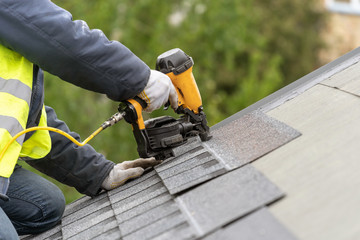Asphalt Shingle Roof Installation involves addressing several components. These components include a rafter to provide the framework for the roof, sheathing as the solid base layer, and water and ice insulation. These elements help reduce the amount of solar heat gained into the attic. Without these components, the asphalt shingles cannot adequately seal the roof. To prevent these problems, a qualified professional must install your new roof.

The cost of an asphalt shingle roof depends on the style and durability of the shingles. Most asphalt shingles are made of adhesive asphalt and ceramic granules. Premium shingles are typically heavier and more wind resistant. Manufacturers warranty their products for twenty years. Some warranties extend to lifetimes. It is always best to compare quotes from three professional contractors. Moreover, don’t be afraid to ask for more than one estimate to understand costs better.
Once you have determined the cost of a new roof, the next step is to determine its weight. The weight of a new roof largely depends on the home’s construction. However, it would be best if you remembered that dimensional shingles are heavier than 3-tab asphalt shingles. As a result, they can last thirty years or longer. This type of roof is also cheaper to install than the three-tab variety. If you’re concerned about weight, opt for the 3-tab type.
Ensure the shingles are installed over the drip edge. If you have a flat roof, you can install a drip edge with a single layer of 15-lb asphalt-saturated felt. You should secure this layer with a pair of nails. It should extend 12 inches above the bottom edge of the exposed asphalt shingle. Then, proceed to the next step of the installation – placing the ridge cap shingles along the ridge of the roof.
The first step in the process of asphalt shingle roof installation is to hire a roofing contractor. The contractor will take all necessary measurements and provide an estimate. Typically, you’ll need about 50 bundles of asphalt shingles for a roof. A roofing contractor should tear off the old roofing material first and then measure the area of the roof before installing the new asphalt shingles. Once the contractor knows the total cost, they’ll proceed to the next step – asphalt shingle roof installation.
Once the shingles are installed, you must purchase felt paper to protect the wood decking underneath them. In addition to helping shed water, felt paper helps increase the roof’s fire rating. Felt paper comes in 15-lb and 30-lb varieties. The latter is stronger and wrinkles less. Walking on your roof with a steep pitch is also safer. If hiring a roofing contractor, ensure they provide you with three or four quotes. Then, you’ll be able to choose the best one within your budget.
Once the asphalt shingles are installed, the labor cost will vary. The average labor cost of 3,000 square feet of roof installation with asphalt shingles is $1,025-$1,100. Depending on the roof size, your contractor will remove and recycle old roofing materials. If you’re doing the job yourself, expect to pay between $1700 and $30,000 for the entire project. You’ll also need to factor in any extra materials you need.
Then, you’ll need to install fasteners to secure the shingles to the roof. You’ll need four pins per shingle or two per individual shingle. Make sure to follow the manufacturer’s recommendations regarding shingle placement, as well as the placement of the fasteners. Make sure you use the minimum number of nails required by the manufacturer. Using too many nails or staples may allow wind to get under the shingles.
In addition to the underlayment, you’ll also need to use an ice and water membrane. This rubberized layer seals the fasteners and gives the asphalt shingles extra water-shedding protection. When installing asphalt shingles, always ensure that your shingles are correctly spaced. If your roof slope is more than twenty units vertical and 12 units horizontal, you’ll need special fastening methods. In addition, you’ll need to consider the location of any plumbing stacks, attic vents, or chimneys. Whether or not you have ice and water issues, include eaves flashings and use ice and water protection membranes to protect these areas.